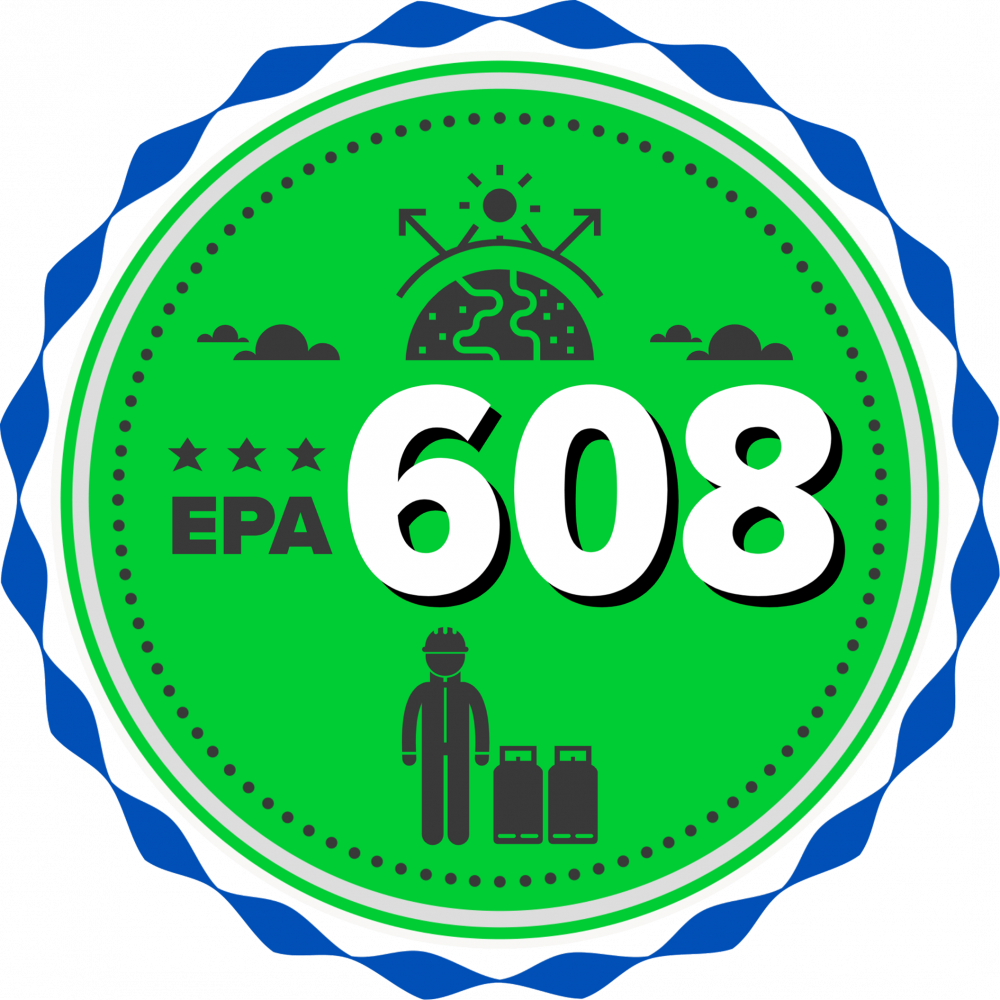What Are EPA Section 608 Regulations?
EPA Section 608 regulations are part of the Clean Air Act, which governs the handling of refrigerants that contribute to ozone depletion and global warming. These regulations specifically target the use of chlorofluorocarbons (CFCs), hydrochlorofluorocarbons (HCFCs), and hydrofluorocarbons (HFCs) in air conditioning and refrigeration systems.
The key objectives of Section 608 are:
- Preventing refrigerant leaks: Minimizing the release of refrigerants during maintenance, repair, or disposal.
- Proper recovery and recycling: Ensuring that refrigerants are recovered, recycled, or reclaimed instead of being vented into the atmosphere.
- Certification requirements: Mandating that technicians handling refrigerants are properly certified.
- Recordkeeping: Requiring detailed records of refrigerant handling activities.
Who Needs to Comply with EPA Section 608?
Compliance with Section 608 is mandatory for:
- HVAC technicians: Anyone who services, repairs, or disposes of air conditioning or refrigeration equipment.
- Contractors and companies: Businesses that employ technicians to handle refrigerants.
- Equipment owners: Owners of air conditioning or refrigeration systems that use regulated refrigerants.
- Reclaimers and recyclers: Facilities that recover, recycle, or reclaim refrigerants.
If you work with systems containing more than 50 pounds of refrigerant, you are subject to these regulations.
Key Requirements of EPA Section 608
To comply with EPA Section 608, you must adhere to the following requirements:
1. Technician Certification
- Who needs certification?: Anyone who performs activities such as maintenance, service, repair, or disposal of air conditioning or refrigeration equipment must be certified.
- Types of certification:
- Type I: For servicing small appliances (e.g., household refrigerators, window AC units).
- Type II: For servicing or disposing of high- or very high-pressure appliances (e.g., commercial AC systems).
- Type III: For servicing or disposing of low-pressure appliances (e.g., chillers).
- Universal: For technicians who work on all types of equipment.
- How to get certified: Certification is obtained by passing an EPA-approved exam administered by a certifying organization.
2. Refrigerant Handling Practices
- Leak prevention: Technicians must use best practices to prevent refrigerant leaks during servicing.
- Recovery and recycling: Refrigerants must be recovered using EPA-approved recovery equipment and either recycled on-site or sent to a reclaimer for processing.
- Prohibition of venting: It is illegal to intentionally vent refrigerants into the atmosphere.
3. Leak Repair Requirements
- Leak inspection: Systems containing 50 pounds or more of refrigerant must be regularly inspected for leaks.
- Leak repair thresholds:
- Commercial refrigeration: Repair leaks if the leak rate exceeds 20% of the charge per year.
- Industrial process refrigeration: Repair leaks if the leak rate exceeds 30% of the charge per year.
- Comfort cooling (e.g., AC systems): Repair leaks if the leak rate exceeds 10% of the charge per year.
- Timeline for repairs: Leaks must be repaired within 30 days of discovery.
4. Recordkeeping
- Required records:
- Records of refrigerant purchases, sales, and transfers.
- Records of refrigerant recovered, recycled, or reclaimed.
- Leak inspection and repair records.
- Service records for equipment containing more than 50 pounds of refrigerant.
- Retention period: Records must be kept for at least 3 years.
5. Equipment Requirements
- Recovery equipment: Technicians must use EPA-certified recovery equipment that meets specific performance standards.
- Reclaimer standards: Refrigerants sent for reclamation must meet AHRI Standard 700 purity specifications.
Steps to Ensure Compliance with EPA Section 608
1. Get Certified
- Ensure that all technicians handling refrigerants are properly certified. This includes passing the appropriate EPA certification exam.
2. Use Proper Equipment
- Invest in EPA-approved recovery and recycling equipment. Regularly maintain and calibrate this equipment to ensure it functions correctly.
3. Follow Best Practices
- Train technicians on proper refrigerant handling procedures, including leak prevention, recovery, and recycling.
- Use recovery cylinders that are properly labeled and meet DOT standards.
4. Conduct Regular Leak Inspections
- Implement a routine leak inspection program for systems containing 50 pounds or more of refrigerant.
- Use leak detection tools such as electronic leak detectors, ultrasonic detectors, or dye kits.
5. Repair Leaks Promptly
- If a leak is detected, repair it within the required timeframe (30 days for most systems).
- Verify the repair by conducting a follow-up inspection.
6. Maintain Accurate Records
- Keep detailed records of all refrigerant-related activities, including purchases, sales, recovery, recycling, and leak repairs.
- Use a digital or paper-based system to organize and store these records.
7. Stay Informed
- Regularly review updates to EPA regulations and industry standards.
- Attend training sessions or workshops to stay current on best practices.
Penalties for Non-Compliance
Failure to comply with EPA Section 608 regulations can result in significant penalties, including:
- Fines: Up to $44,539 per day per violation for intentional venting of refrigerants.
- Loss of certification: Technicians may lose their certification, preventing them from working on refrigerant systems.
- Legal action: Companies may face lawsuits or other legal consequences.
Benefits of Compliance
Complying with EPA Section 608 regulations offers several benefits:
- Environmental protection: Reducing the release of ozone-depleting substances helps protect the environment and public health.
- Cost savings: Proper leak prevention and refrigerant recovery can save money by reducing the need for costly refrigerant purchases.
- Reputation: Demonstrating compliance enhances your company’s reputation as a responsible and environmentally conscious business.
Conclusion
Complying with EPA Section 608 regulations is essential for protecting the environment and avoiding costly penalties. By ensuring that your technicians are certified, using proper equipment, conducting regular leak inspections, and maintaining accurate records, you can meet all regulatory requirements and contribute to a healthier planet.
If you’re unsure about any aspect of Section 608 compliance, consult the EPA’s official guidelines or seek advice from industry experts. Remember, compliance isn’t just a legal obligation—it’s a commitment to sustainability and environmental stewardship.
Additional Resources:
By following this guide, you’ll be well-equipped to navigate the complexities of EPA Section 608 regulations and ensure your operations are fully compliant.


